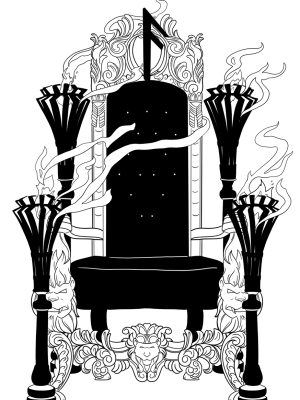Njordr Spirits
Haugbui
Some souls of those who escape Sveas become deeply attached to the areas they loved or met their end. These spirits are content to remain reliving their beloved traditions, some are viewed as protectors or a reminder of the transgressions that took place. The most well known Haugbui is the stargazer of the Runeheim Menhir. He is seen beside the Menhir on a bed of furs whenever the moon is dark, looking listlessly up at the stars. He welcomes guests to lay beside him and offers visitors a share of his mead and speaks about his views of the world.
Unlike Draugr, the Haugbui mean no harm to passersby, that is unless their grave has been disturbed. It is said that a Haugbui becomes violently vengeful, succumbing to madness unable to rest until the desecrator has been punished. Often a village will offer the perpetrator to the angered Haugbui as to not incur its wrath in its attempts to enact vengeance.
Drengr
The Drengr are considered spirits of honor and their pursuit is rarely interfered with by bystanders. Drengr haunt those who commit actions of great dishonor. They have pursued those that demand dishonorable challenges, be it either preying on an elderly crafter by demanding physical combat or killing someone for their refusal to accept a challenge.
Drengr are the reason Njords rarely issue challenges for being called out for anything less than a deadly sin. Even then, it is sometimes better to accept the repercussions of their Sins being called out than to risk the ire of the Drengr. It is said that proper recompense to the offended party, pleading for forgiveness, or oaths to never commit the deed again can placate a Drengr. Though few souls have ever survived repeatedly angering the Drengr.
Dis (Disir; plural)
Branded women hold the reigns of their fate and the fate of others even after death. They will go on existing as a sort of ancestral ghost called the Dis that watches over the clan and visits wickedness upon its enemies. These women return in time of greatest need to warn of impending doom, to lead the worthy to safety, or fight against the fiercest of enemies that threaten Njordr.
The White Eyes clan, especially its men, venerate their clan’s Disir and have many stories of women clad in armor with stark white hair appearing before roving Orcs, or beasts of the tundra have attacked their encampments.
The most well known Disir of the White Eyes are the Grimsdottr sisters, Aloisa “Dragon Speaker” and Aina “Fire Breaker”. The pair of Disir have been seen on many occasions offering their help to the White Eyes clan. It is said long ago a small dragon wreaked havoc on villages in the far north, retreating to the highest mountain tops by daylight. Even the smallest of dragons was a momentous adversary for the warriors of Njordr and many warriors seeked a name by slaying the beast. Aina and Aloisa set out to test their fate. Some weeks later they appeared from the snow, their skin scarred by fire and chard flesh hanging from their bodies. Aloisa had tracked the creature into the deep mountains claiming to be able to hear whispers of the dragon’s voice. Aina fought the creature in a mighty battle, where with the skilled use of a shield was able to block the dragon’s fiery breath allowing her to slay the great beast.
Holidays
Tressertag - Gothic Holiday
Tressertag is an ancient holiday, taking place in the last days of winter, and dating back to the oldest traditions, and is a holiday shared with their cousins the Njords. On this day, a game is made of “capturing” a wife for one’s own. The first man to place a woven cuff on the wrist of a maiden can make her his bride for the day. What exactly that role constitutes in the nature of the holiday is somewhat ambiguous. In some towns it means the capturing man might be entitled to a kiss. In other towns, a blind eye is turned to whatever might happen. This is the most popular day of the year for a man to declare his love for a woman and give his marriage proposal. Popular, pretty and wealthy girls are often hidden on this day by their families behind walls of their brothers or their father and not allowed to come out that day. In some cases competition for a given woman might be rather fierce, and more than one rivalry has become deadly serious. It isn’t unheard of for young men to scale the outside walls of a girl’s home to make it into their windows on such a day, or other far fetched schemes.
Wheat Lord's Festival
In the vital days before winter snows beset the north villages gather together to take part in the Wheat Lord’s festival in order to make sure the last of the harvesting has come together. It is a celebration of the work of winter preparations and takes place from noon to sunset. The town is decorated in the colors of Autumn, reds oranges and yellows. Games are arranged for children and adults alike, occasionally even featuring prizes. The Festival is also a time where people are recognized for their contribution throughout the year, particularly the farmers and the Wheat Lord, who is crowned at the beginning of the festival. The Hearthwise prepare a feast, a banquet of sweet breads and fresh fruit and vegetables, and offer any who choose to partake, sharing the bounty of the Harvest with the people.
